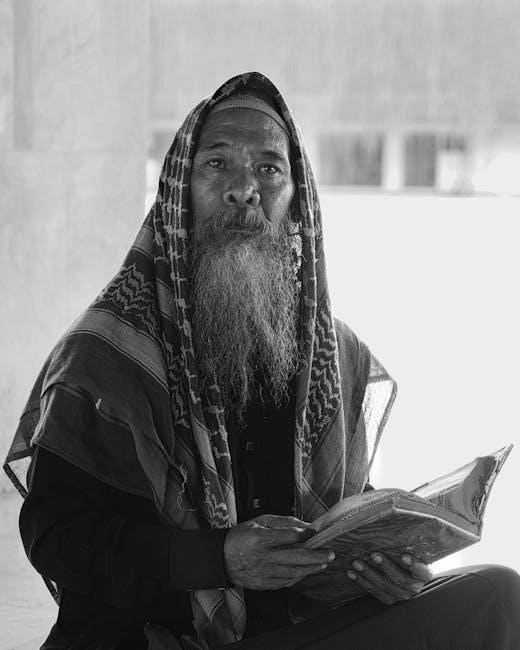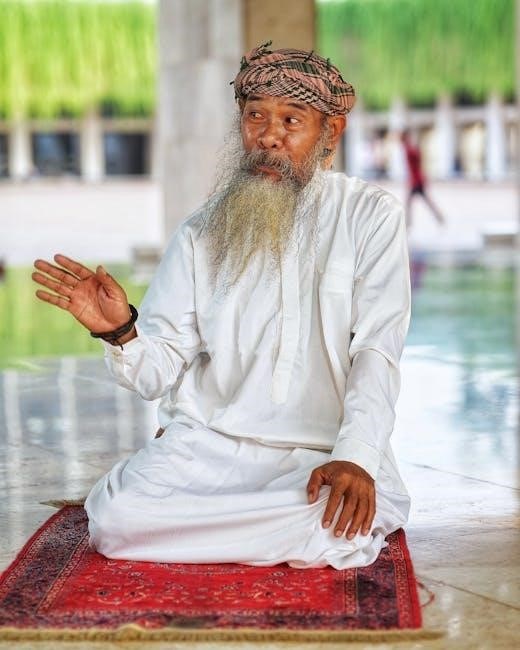The Jakarta Method by Vincent Bevins exposes the U.S.-backed anticommunist violence in Indonesia during 1965, revealing how mass murder became a tool for global political control, reshaping Cold War dynamics.
1.1 Background of the Jakarta Method
The Jakarta Method refers to the 1965-66 mass killings in Indonesia, where the U.S.-backed military exterminated approximately one million alleged communists and leftists. This brutal campaign, supported by Washington, aimed to eliminate the Indonesian Communist Party, then the third-largest in the world. The method involved systematic targeting, torture, and execution, often using lists provided by Western intelligence agencies. This dark chapter set a precedent for similar anticommunist purges globally, inspiring copycat programs in Latin America, Africa, and Asia. The term “Jakarta Method” encapsulates the Cold War’s violent underbelly, where mass murder became a tool for geopolitical control, reshaping nations and leaving lasting scars on global politics and human rights.

1.2 Importance of Understanding the Jakarta Method
Understanding the Jakarta Method is crucial for grasping the Cold War’s true nature and its enduring impact on global politics. This dark chapter reveals how mass violence was systematically used as a political tool, reshaping nations and ideologies. The method’s global spread, inspiring similar campaigns elsewhere, highlights its significance in modern geopolitics. By examining this history, we uncover the role of Western powers in perpetuating authoritarian regimes and the suppression of leftist movements. This knowledge challenges the narrative of a peaceful transition to a U.S.-led capitalist world, exposing the brutal realities behind it. It serves as a cautionary tale, offering lessons for today’s world on the dangers of imperialism and the erosion of human rights.

Historical Context
The Jakarta Method is rooted in the Cold War’s ideological battles and Indonesia’s post-independence turmoil, where U.S.-backed anticommunist campaigns led to mass violence and political upheaval.
2.1 The Cold War and Its Global Impact
The Cold War shaped global politics, pitting capitalist and communist ideologies against each other. The U.S. sought to contain communism, often through covert operations and alliances with authoritarian regimes. This era of ideological conflict influenced nations like Indonesia, where political instability and fear of communist expansion created fertile ground for intervention. The Jakarta Method highlights how the U.S. exploited these tensions, supporting mass violence to eliminate leftist movements. Such actions not only reshaped Indonesia but also set a precedent for similar strategies worldwide, demonstrating the far-reaching consequences of Cold War geopolitics on local populations and international relations.
2.2 Indonesia’s Independence and Political Landscape
Indonesia gained independence from the Netherlands in 1945, emerging as a nation with a diverse population and complex political landscape. President Sukarno’s socialist-oriented government faced challenges from various factions, including the Indonesian Communist Party (PKI), which became a significant political force. The U.S. viewed Indonesia as a critical Cold War battleground, fearing communist expansion in Southeast Asia. This led to covert interventions aimed at destabilizing Sukarno’s government. The political instability and ideological tensions created an environment where external powers, particularly the U.S., could exert influence. The eventual rise of the military, supported by Western interests, set the stage for the tragic events of 1965, reshaping Indonesia’s trajectory and global implications.

Key Events of the Jakarta Method
The 1965 massacres in Indonesia marked the brutal elimination of over one million alleged communists, backed by U.S. support, reshaping the nation’s political landscape forever.
3.1 The 1965 Massacres in Indonesia
In 1965, Indonesia witnessed a brutal campaign of mass killings targeting communists, leftists, and ethnic Chinese. Backed by the U.S., the Indonesian military orchestrated the elimination of over one million civilians, marking one of the deadliest anticommunist purges in history. The violence followed the failed coup attempt by the September 30th Movement, which the military blamed on the Communist Party of Indonesia (PKI). This event set a chilling precedent for similar campaigns worldwide, solidifying the Jakarta Method as a Cold War strategy to suppress leftist movements through state-sponsored terror and mass murder.
3.2 U.S. Involvement and Support
The U.S. government played a pivotal role in the 1965 massacres by providing critical support to the Indonesian military. This included supplying weapons, intelligence, and lists of suspected communists, enabling the systematic elimination of the Communist Party of Indonesia (PKI). The U.S. viewed Indonesia as a strategic location in Southeast Asia and saw the PKI as a threat to its interests. By backing the military regime, Washington effectively endorsed the mass killings as a means to consolidate anticommunist control. This intervention not only facilitated the deaths of over one million Indonesians but also set a precedent for similar U.S.-backed campaigns elsewhere, solidifying the Jakarta Method as a Cold War-era strategy for suppressing leftist movements through state-sponsored violence.

Global Implications
The Jakarta Method inspired similar anticommunist campaigns worldwide, shaping Cold War geopolitics and demonstrating how mass violence could be weaponized to impose political ideologies globally.

4.1 The Spread of Anticommunist Crusades
The Jakarta Method became a blueprint for U.S.-backed anticommunist campaigns worldwide. After Indonesia’s 1965-66 mass killings, similar strategies were adopted in Latin America, Africa, and Asia. The U.S. supported authoritarian regimes that used violence to eliminate leftist movements, ensuring the spread of capitalist ideologies. This approach solidified Washington’s influence during the Cold War, creating a network of anticommunist alliances; The method’s success in Indonesia inspired copycat programs, leading to widespread human rights abuses. By exporting this model, the U.S. reshaped global politics, often at the cost of democratic values and civilian lives. The legacy of these crusades continues to influence modern geopolitical strategies and authoritarian governance.
4.2 Impact on Other Countries and Regions
The Jakarta Method had far-reaching consequences beyond Indonesia, inspiring similar anticommunist campaigns globally. In Latin America, Africa, and Asia, U.S.-backed regimes adopted violent strategies to suppress leftist movements. Countries like Brazil, Argentina, and Chile saw mass killings, disappearances, and political repression, mirroring Indonesia’s 1965-66 atrocities. This U.S.-led initiative entrenched authoritarian rule, stifled democratic movements, and reshaped political landscapes. The method’s global application led to widespread human rights abuses, undermining social progress and fostering long-term instability. Its legacy is evident in the enduring inequality and political repression in regions where such tactics were employed, highlighting the devastating cost of Cold War ideologies.
4.3 The Role of the CIA and Military
The CIA and U.S. military played a pivotal role in the Jakarta Method, providing strategic support and resources to Indonesia’s anticommunist forces. Declassified documents reveal that the CIA supplied lists of suspected communists, directly contributing to the 1965-66 massacres. Military aid, including weapons and training, was funneled to the Indonesian army, enabling their brutal campaigns. This covert involvement was part of a broader Cold War strategy to eliminate leftist movements worldwide. The CIA’s actions not only facilitated mass murder but also set a precedent for future interventions, solidifying the U.S.’s role in global anticommunist operations and shaping the geopolitical landscape of the 20th century.

The Book Details
The Jakarta Method by Vincent Bevins, published in 2020 by PublicAffairs, uncovers the U.S.-backed anticommunist crusade in Indonesia, detailing its global impact and historical significance.
5.1 Title and Author

The book, titled The Jakarta Method: Washington’s Anticommunist Crusade and the Mass Murder Program that Shaped Our World, is authored by Vincent Bevins. Published in 2020 by PublicAffairs, it delves into the U.S.-backed anticommunist campaign in Indonesia during 1965, exposing the mass violence and its far-reaching global consequences. Bevins, a renowned journalist, meticulously documents how this dark chapter of Cold War history influenced political landscapes worldwide; The title reflects the systematic approach used to suppress communism, which became a model for other nations. This work is a critical examination of the intersection of geopolitics, violence, and ideology, offering a fresh perspective on a often-overlooked period.
5.2 Publication Date and Publisher
The Jakarta Method: Washington’s Anticommunist Crusade and the Mass Murder Program that Shaped Our World was published in 2020 by PublicAffairs, an esteemed publishing house based in New York. The book’s initial release marked a significant contribution to Cold War historical studies, shedding light on the U.S.-backed atrocities in Indonesia. Its publication sparked widespread academic and public interest, leading to subsequent editions, including a paperback release in 2021. The publisher’s commitment to producing high-quality, thought-provoking works aligns with the book’s critical examination of global geopolitics and violence. This publication has been instrumental in bringing overlooked historical events to the forefront of contemporary discourse;
5.3 Book Structure and Content
The Jakarta Method is structured into 12 chapters, each delving into specific aspects of the U.S.-backed anticommunist campaign in Indonesia and its global repercussions. The book begins with an introduction that sets the historical stage, followed by chapters that explore the 1965 massacres, U.S. involvement, and the spread of similar tactics worldwide. Bevins meticulously examines declassified documents, eyewitness testimonies, and archival research to construct a compelling narrative. The chapters are titled to reflect key events and themes, such as “A New American Age,” “Independent Indonesia,” and “Jakarta Is Coming.” The book concludes with reflections on the long-term legacy of the Jakarta Method, offering a comprehensive analysis of its impact on global politics and human rights. This structure ensures a detailed yet accessible exploration of a dark chapter in Cold War history.
5.4 Reception and Reviews
The Jakarta Method has garnered significant attention and acclaim for its bold and comprehensive examination of a lesser-known chapter of Cold War history. Reviewers praise Bevins’ meticulous research, drawing from declassified documents and eyewitness accounts, which sheds light on the U.S.-backed mass murder program in Indonesia. The book has been described as a “gripping exploration” and “thoroughly original,” challenging conventional narratives of the Cold War. Many journalists and scholars have highlighted its relevance to understanding modern geopolitics and the legacy of U.S. foreign policy. The book’s ability to connect Indonesia’s 1965 atrocities to broader global patterns of anticommunist violence has resonated with readers, making it a critical work for those interested in history, politics, and human rights.
Author Background
Vincent Bevins is an American journalist and author specializing in history, politics, and international relations, known for his in-depth research on Cold War dynamics and U.S. foreign policy.
6.1 Vincent Bevins: Biography
Vincent Bevins is an American journalist and author, known for his investigative work on global politics and history. He has reported from Latin America, Asia, and Europe, focusing on themes like inequality, democracy, and U.S. foreign policy. Bevins holds a Ph.D. in International Relations and has worked for major media outlets, including the Washington Post and Financial Times. His book, The Jakarta Method, has garnered international attention for its detailed examination of Cold War atrocities and their global implications. Bevins’ work is celebrated for its meticulous research and ability to connect historical events to contemporary issues, making him a respected voice in both journalism and academia.
6.2 Bevins’ Research and Sources
Vincent Bevins’ research for The Jakarta Method is rooted in meticulous archival work and declassified documents, uncovering the U.S. role in Indonesia’s 1965 massacres. He draws from eyewitness testimonies, international archives, and previously unexplored records to construct a comprehensive narrative. Bevins’ sources include newly released CIA files, Indonesian military records, and interviews with survivors, providing a detailed account of the atrocities. His work challenges the conventional Cold War history, offering a fresh perspective on U.S. foreign policy and its global implications. By integrating diverse primary sources, Bevins delivers a well-documented analysis that has been critically acclaimed for its depth and originality, shedding light on a dark chapter of international relations.
Themes and Arguments
The book explores the U.S. role in global anticommunist violence, the use of mass murder as a political tool, and the enduring legacy of Cold War ideologies shaping modern geopolitics.
7.1 The Role of the U.S. in Global Politics
The Jakarta Method reveals how the U.S. leveraged anticommunist ideology to exert global influence, supporting mass violence in Indonesia and beyond. By backing authoritarian regimes and military crackdowns, Washington reshaped political landscapes, prioritizing capitalist alignment over human rights. This strategy, rooted in Cold War paranoia, demonstrated the U.S.’s willingness to use covert operations and propaganda to suppress leftist movements worldwide. The book highlights how such interventions created a template for suppressing dissent, fostering authoritarianism, and maintaining U.S. hegemony. Bevins argues that these actions not only devastated local populations but also set a dangerous precedent for future interventions, shaping the modern geopolitical order.
7.2 Mass Murder as a Political Tool
The Jakarta Method chillingly illustrates how mass murder was systematically employed as a political strategy during the Cold War. In Indonesia, the U.S.-backed military regime orchestrated the extermination of approximately one million alleged communists, leftists, and ethnic minorities between 1965 and 1966. This brutal campaign was not merely an act of violence but a calculated effort to eliminate political opposition and consolidate power. The method served as a blueprint for other authoritarian regimes worldwide, demonstrating how state-sponsored terror could reshape societies and suppress dissent. Bevins’ work reveals the horrifying efficiency of such tactics, where mass killings were justified as necessary for ideological purity and geopolitical stability, leaving deep scars on affected nations and their people.
7.3 The Legacy of the Cold War
The Jakarta Method underscores the enduring legacy of the Cold War, where ideological battles often led to unprecedented violence. The 1965 Indonesian massacres, supported by the U.S., exemplify how anticommunist rhetoric justified mass atrocities, shaping global geopolitics. This dark chapter reveals how the Cold War’s proxy wars and political alignments perpetuated human rights abuses, leaving lasting scars on affected nations. Bevins’ work highlights how such events were not isolated but part of a broader pattern of state-sponsored violence that influenced other regions. The legacy of the Cold War, as shown in this book, is one of suppressed histories, unresolved injustices, and the long shadow of superpower intervention in domestic affairs, continuing to impact modern international relations and global stability.

Evidence and Documentation
The book relies on declassified documents, archival research, and eyewitness testimonies to expose the U.S. role in Indonesia’s 1965 massacres, providing a chilling, evidence-based narrative.
8.1 Declassified Documents
Declassified U.S. government documents reveal the extent of American involvement in Indonesia’s 1965 massacres. These files detail how the CIA and other agencies provided lists of communist party members to the Indonesian military, directly contributing to the mass killings. The documents also show U.S. awareness of the atrocities, with embassy officials acknowledging the scale of the violence. Such evidence contradicts earlier claims of U.S. neutrality, exposing a deliberate strategy to eliminate leftist movements. The declassified records are a critical part of Bevins’ research, offering irrefutable proof of U.S. complicity in one of the 20th century’s most horrific mass murder campaigns.
8.2 Eyewitness Testimonies
Eyewitness testimonies from survivors, former soldiers, and villagers provide harrowing accounts of the 1965 massacres in Indonesia. These personal narratives detail the brutal killings, mass graves, and systematic targeting of communists and alleged leftists. Survivors recount the terror of witnessing family members and neighbors being rounded up and executed, often with the direct involvement of the Indonesian military. Their stories also highlight the role of U.S.-backed forces in orchestrating the violence. These testimonies, often collected decades later, offer a deeply personal perspective on the atrocities, corroborating the evidence from declassified documents. They underscore the enduring trauma and fear experienced by those who lived through the Jakarta Method, leaving an indelible mark on Indonesia’s history.
Legacy of the Jakarta Method
The Jakarta Method left deep scars, shaping Indonesia’s political landscape and inspiring similar anticommunist campaigns globally, while the trauma of mass murders remains etched in survivors’ memories.
9.1 Long-Term Effects on Indonesia
The Jakarta Method had devastating long-term effects on Indonesia, leading to the elimination of the Communist Party and the rise of authoritarian rule under General Suharto. The 1965 massacres resulted in the deaths of approximately one million civilians, creating a climate of fear and political repression. Civil society was severely weakened, and dissent was silenced for decades. The event marked a shift from democratic aspirations to a military-dominated regime, which lasted until Suharto’s fall in 1998. The trauma of the mass killings and forced disappearances left deep scars, with survivors and families enduring lasting psychological and social impacts. Indonesia’s political landscape and societal fabric were forever altered, as the nation struggled to reconcile with its violent past.
9.2 Influence on Modern Geopolitics
The Jakarta Method has had a profound influence on modern geopolitics, as it set a precedent for U.S.-backed anticommunist campaigns worldwide. The 1965 Indonesian massacres inspired similar strategies in Latin America and beyond, shaping Cold War-era interventions. The method’s emphasis on eliminating political opposition through violence became a blueprint for authoritarian regimes aligned with Western interests. Today, the legacy of the Jakarta Method is evident in ongoing struggles against impunity and the rise of authoritarianism in various regions. It highlights the long-term consequences of foreign intervention and the enduring impact of Cold War ideologies on global power dynamics, challenging modern notions of democracy and human rights.
Modern Relevance

The Jakarta Method remains relevant today, exposing the dark legacy of U.S. foreign policy and inspiring modern anti-imperialist movements to confront historical injustices and ongoing geopolitical tensions.
10.1 Current Implications
The Jakarta Method highlights the enduring impact of Cold War strategies on modern geopolitics. By examining the U.S.-backed mass violence in Indonesia, the book reveals how such interventions shaped global power dynamics. Today, the legacy of these actions influences anti-imperialist movements and critiques of U.S. foreign policy. The book serves as a cautionary tale, urging readers to reflect on the long-term consequences of political violence and the ethical responsibilities of global powers. Its relevance is heightened by current debates on imperialism, human rights, and the role of Western nations in shaping international relations. The Jakarta Method thus remains a vital resource for understanding both historical and contemporary geopolitical challenges.
10.2 Lessons for Today’s World
The Jakarta Method offers critical lessons for understanding the dangers of imperialism and the exploitation of political ideologies. It underscores the importance of accountability for state-sponsored violence and the need for transparency in foreign policy. The book highlights how mass murder was justified as a means to achieve political stability, a tactic with eerie parallels in modern conflicts. It also emphasizes the role of media in shaping public perception and the ethical responsibility of global powers. These lessons serve as a warning against repeating history, urging nations to prioritize human rights and diplomacy over ideological conquest. The Jakarta Method reminds us that the consequences of such actions reverberate for generations, making it essential to learn from the past to build a more just future.
The Jakarta Method exposes a dark chapter of Cold War history, revealing how U.S.-backed violence shaped global politics. It serves as a stark reminder of the dangers of ideological extremism and the importance of accountability in international relations, urging us to learn from the past to prevent future atrocities.
11.1 Summary of Key Points
The Jakarta Method reveals the U.S.-backed anticommunist campaign in Indonesia during 1965, resulting in the massacre of approximately one million civilians. It highlights how mass murder was systematically used as a political tool to eliminate communists and reshape global power dynamics. The book underscores the role of the CIA and military in supporting such violence, which inspired similar strategies worldwide. By examining declassified documents and eyewitness testimonies, Bevins exposes the dark legacy of Cold War ideologies and their enduring impact on international relations. This grim history serves as a cautionary tale about the dangers of ideological extremism and the importance of accountability in global politics.
11.2 Final Thoughts and Reflections
The Jakarta Method offers a chilling reminder of the devastating consequences of ideological extremism and geopolitical ambition. By exposing the U.S.-backed mass murders in Indonesia, Bevins underscores the moral failures of Cold War strategies and their lasting impact on global stability. The book serves as a warning against the dangers of unchecked power and the erosion of human rights in the pursuit of political goals. It challenges readers to reflect on the legacy of colonialism and imperialism, urging a more nuanced understanding of history to prevent similar atrocities in the future. This gripping account is a call to action for accountability and justice in international relations.
